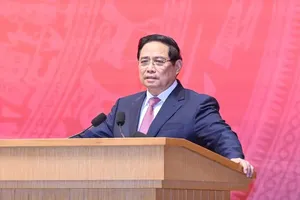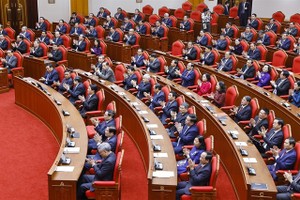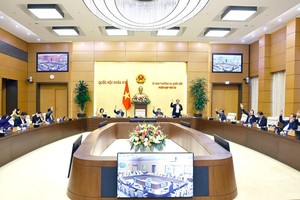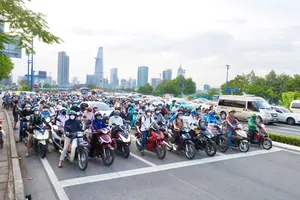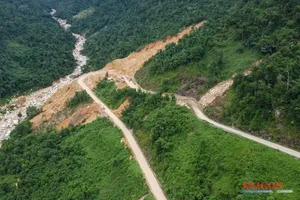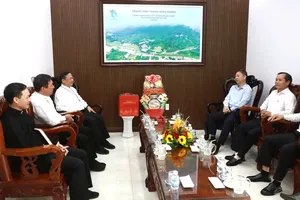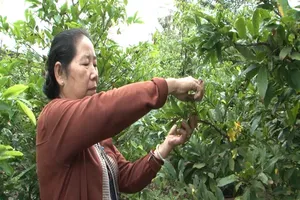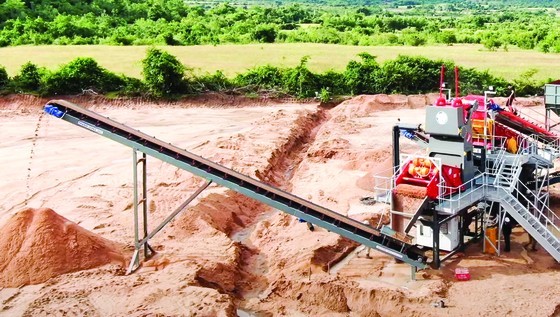 |
A construction project in the Mekong Delta utilizing crushed sand from rocks (Photo: SGGP) |
Pressure of insufficient supply and environmental impact
In mid-September 2023, a delegation led by Mr. Nguyen Van Hieu, Secretary of the Can Tho City Party Committee, had a working session with An Giang Province's leadership on supplying sand for the Chau Doc - Can Tho - Soc Trang highway project. Can Tho City and Hau Giang Province are struggling with the issue of supplying sand for construction contractors after experiencing delays in projects' progress.
In the period from 2022 to 2025, the Mekong Delta region plans to implement four highway projects of Can Tho - Ca Mau, Chau Doc - Can Tho - Soc Trang, Cao Lanh - An Huu, and My An - Cao Lanh.
These projects require approximately 40 million cubic meters of sand for backfilling, with 17 million cubic meters needed in 2023 and 23 million cubic meters needed in 2024 and 2025. However, the mining capacity of sand mines in the Mekong Delta can only meet about 50 percent of this demand. This is the main reason for the delays in project execution in the region.
To address this bottleneck, Deputy Prime Minister Tran Hong Ha requested that localities in the upper reaches of the Tien and Hau rivers ensure sand sources for highway construction projects in the region, particularly the Can Tho - Ca Mau highway. He emphasized the need to ensure a sand supply while also preventing negative environmental impacts and erosion.
An Giang Province previously committed to providing approximately 7.5 million cubic meters of sand for the Chau Doc - Can Tho - Soc Trang highway project from sand mines along the Tien River in Binh Phuoc Xuan Commune and the Cu Lao Tay Branch in Cho Moi District.
However, according to Chairman of the An Giang Province People's Committee Nguyen Thanh Binh, this river branch was part of the national inland waterway routes, not a mineral sand mine, making it ineligible for exploitation.
For the Can Tho - Ca Mau highway project, An Giang Province will supply the required 3.3 million cubic meters of sand from six sand mines within its territory. However, these mines are currently under revocation of construction permit due to signs of violations.
Mr. Nguyen Thanh Binh informed that to ensure the sand supply as committed, the provincial People's Committee is preparing to submit requests to the Standing Party Committee of An Giang to review other sand mines for exploitation permits and is also proposing support from relevant departments to restore previously suspended sand mines.
In Dong Thap, Mr. Pham Thien Nghia, Chairman of the provincial People's Committee, stated that the locality is making efforts to supply the required amount of sand for the national highway projects assigned by the government. However, Dong Thap is currently facing a dilemma. The biggest concern is the mechanism for assigning sand mines to contractors, especially in terms of control and oversight.
According to Mr. Pham Thien Nghia, most contractors lack experience, equipment, and the capacity for sand mining. Therefore, they primarily rely on local authorities to introduce professional sand mining units. The process of selecting mining units and monitoring sand mining activities involves multiple steps and is time-consuming. Any delay or wrong decision could impact the progress of highway construction, leading to violations, overexploitation, affecting water flow, and increasing the risk of erosion.
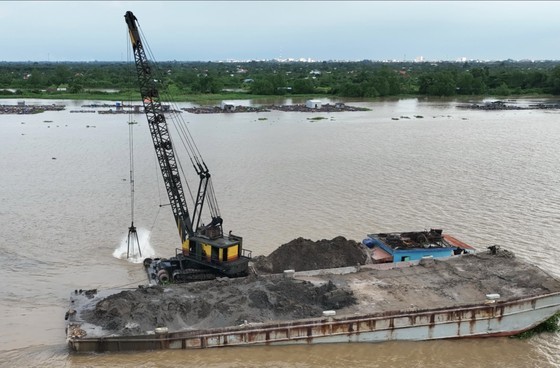 |
Sand mining in Tan Chau Town of An Giang Province (Photo: SGGP) |
Finding alternative backfilling materials to replace river sand
According to Nguyen Trung Hieu, Director of Business at Thanh Long Company, a construction materials distributor in Ho Chi Minh City, the practice of crushing stone into sand for construction projects has been adopted effectively by many countries for about 7-8 years. In Vietnam, numerous construction conglomerates have also successfully implemented this practice.
Many experts and engineers in the construction sector suggest that besides exploiting river sand, local authorities should consider mining sand from islets or from dredging activities in canals and branches. However, the utilization of these sand sources for roadbed backfilling must involve the coordination of multiple ministries and departments to ensure compliance with environmental impact assessments.
Deputy Prime Minister Tran Hong Ha emphasized the need to utilize materials from dredging activities, canal clearing, islets, and sandbanks within the region for backfilling in major national highway projects. This should be carried out with thorough environmental assessments and obtaining legal approvals. Additionally, local inter-agency task forces should be established to oversee sand mining operations for the supply of key national highway projects, ensuring that resources are used for their intended purposes.
Prime Minister Pham Minh Chinh recently signed an official telegram to relevant ministries, including the Ministry of Natural Resources and Environment, the Ministry of Construction, the Ministry of Agriculture and Rural Development, the Ministry of Science and Technology, the Ministry of Transport, and others to expedite research into the use of sea sand for roadbed backfilling in major infrastructure projects. This task must be completed in October 2023.
According to the Ministry of Natural Resources and Environment, with 60 licensed sand mines in the Mekong Delta, the total sand reserve in the region currently approximates 80 million cubic meters, including 63 million cubic meters for backfilling and 17 million cubic meters for construction.
Recently, provinces in the Mekong Delta issued an additional 30 research permits with a reserve of 39 million cubic meters for backfilling and 3 million cubic meters for construction. Consequently, the Mekong Delta currently has approximately 120 million cubic meters of sand, including 100 million cubic meters for backfilling purposes.
